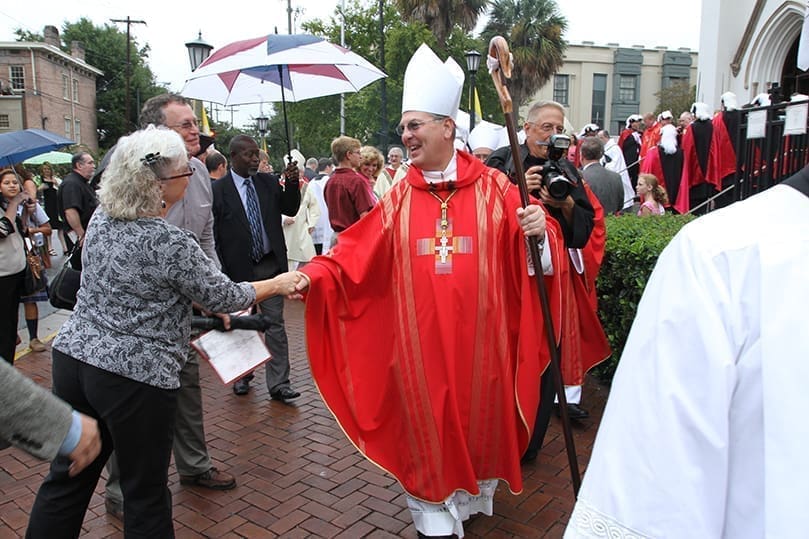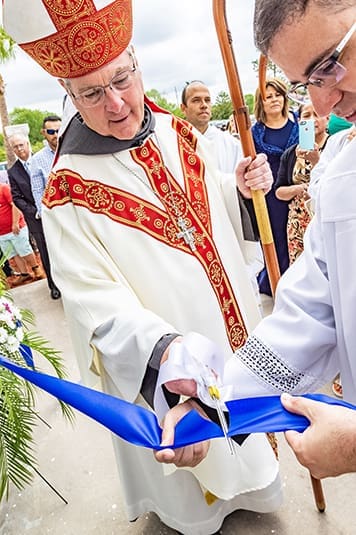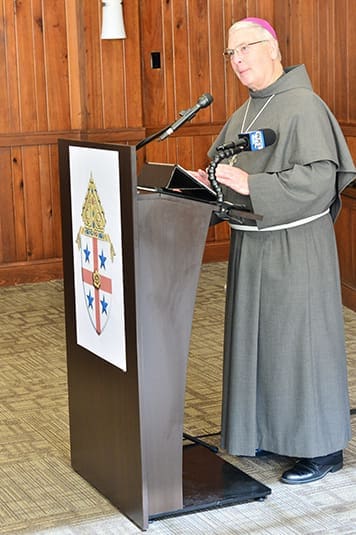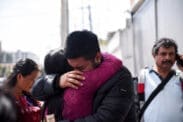 Photo By Michael Alexander
Photo By Michael Alexander
How the Diocese of Savannah formed a bishop
By NICHOLE GOLDEN, Editor | Published May 14, 2020
ATLANTA—In the weeks between his March appointment as Archbishop of Atlanta and the official installation on May 6, Archbishop Gregory Hartmayer, OFM Conv., shared warm words for the people of the Diocese of Savannah and the more than eight years of service there.
The morning the appointment was announced, Archbishop Hartmayer found himself recalling the slideshows his Franciscan teachers would show of mission work in Japan.
“I never wanted to be a missionary,” he said remembering the presentations.
“But I found myself for the first time at the age of 59 living the life of a missionary,” he said about his 2011 appointment as Bishop of Savannah.
In an interview with The Georgia Bulletin on March 5, he talked about ministry in the diocese, which covers 37,038 square miles from Augusta to Columbus and south to the Florida border.
He traveled by car and spent the night somewhere different many evenings.
At the installation, he joked that the appointment to Atlanta is “somewhat of a demotion” as the Archdiocese of Atlanta covers 69 counties and the Diocese of Savannah includes 90.
I’d be remiss not to acknowledge the “cherished Catholic community of Savannah,” said Archbishop Hartmayer at the May 6 Mass of Canonical Installation in Atlanta.
“For the past eight years, we have accompanied one another in faith, we have prayed together, celebrated together, grieved together and deepened our love for our Lord Jesus Christ, together,” he said. “I believe I am leaving Savannah a better person, a better priest and a better bishop because the people taught me so much about what it means to be a disciple of Christ.”
Key accomplishments in Savannah
During his tenure as Bishop of Savannah, Archbishop Hartmayer made it a priority to attend parish and school celebrations throughout the diocese. The archbishop was instrumental in welcoming Franciscan Friars, Missionary Sisters of the Holy Spirit, the Apostles of Jesus and seminarians from Nigeria and Ghana, West Africa, Poland, Mexico and Colombia. He worked to cultivate strong relationships with his priests. Three new churches were built and a new parish created.
Catholic education was a focus of the archbishop, as a longtime educator and graduate of Catholic schools.
During his time, two parochial schools were rebuilt, and a new parochial high school was created in Albany. He approved a special education program in Augusta.
Archbishop Hartmayer talked about fostering the identity of Catholic schools at his appointment press conference in Atlanta.
“I know people choose Catholic schools for a variety of reasons. And I understand that. Some of them are academic. Some of them are athletic, some of them are the arts or music,” he said. “But my major reason for supporting Catholic schools and giving them the attention that I think they need is to ensure that they remain Catholic, and the faith is passed on, in an understandable and practical way.”
The archbishop’s first assignment as a priest was to teach at the school where he had spent his pastoral year. He eventually served as its principal.
Michelle Kroll is superintendent of Catholic schools in Savannah, which has 16 schools and serves more than 4,980 students. Some of the schools are for students in pre-k through twelfth grade combined.

Bishop Gregory Hartmayer, left, cuts a ribbon for the dedication of St. Frances of Rome Church, Alma, in April 2019 with help from Father Pablo Migone, right, chancellor of the Savannah Diocese. Photo Courtesy of the Southern Cross
“He loved visiting schools. He would drop in,” said Kroll.
The Immaculate Conception Catholic School for Special Education in Augusta, a program which he approved, was dear to him, she said.
“He never missed an opportunity when he was in Augusta to go and visit those children,” said Kroll. “He has a special place in his heart for Immaculate Conception.”
The program met “a real need for families who are Catholic and wanted to send their child to a special needs program,” she said. “He was all on board with it.”
Another success story in the education ministry was the addition of a high school to the parochial school of St. Teresa in Albany. Before that, the closest high school was 100 miles away. The high school opened in the 2017-18 school year.
Kroll said that 32 high school students are now attending the high school.
Both Kroll and Archbishop Hartmayer have proudly mentioned St. Teresa’s first graduate, Emily Meneses. She graduates this month and has excelled academically and learned more about her faith.
“She got a full ride to Notre Dame,” said Kroll. The full scholarship was awarded through the National College Match Scholarship program.
“We’re doing some wonderful things,” said Kroll.
The superintendent said the bishop was very supportive of GRACE Scholars, the program that makes Catholic education more affordable for families.
“He made it a point to go to school fundraisers,” and to give, said Kroll. “I want him back. He’s extremely responsive.”
From the ground up
The archbishop speaks Spanish, but now says he wishes he’d paid more attention to his Spanish studies as a young person.
During his years in Savannah, he spent a lot of time getting to know the Hispanic community.
“I just love them because they’re such joyful people. They have their crosses to bear there’s no question, but their children, their families and their faith have inspired me,” he said.
Lili Niederkorn, Hispanic Ministry director for the Diocese of Savannah, said that prior to Archbishop Hartmayer’s arrival in Savannah, there was no ministry office.
“He brought more attention to the Hispanic community,” said Niederkorn.
Shortly after his appointment in 2011, the bishop had a meeting with Hispanic priests and leaders. They discussed priorities including a hope for more Masses in Spanish and better access to sacraments.
“He made quick decisions to help the community,” said Niederkorn.
In the bishop’s second year, with support from a Catholic Extension grant, the Hispanic Ministry Office of the diocese was created. The Catholic Extension grant funded the ministry for three years until it was off and running.
In 2013, The Center for Applied Research in the Apostolate (CARA) estimated the number of Hispanic Catholics living in the Savannah Diocese to be 80,122. Some 55 percent of parishes are now offering Mass in Spanish.

Bishop Gregory Hartmayer speaks to the faithful of the Diocese of Savannah during a press conference at the pastoral center. Photo Courtesy of the Southern Cross
Niederkorn said the bishop supported creation of the Hispanic Ministry council.
“Bishop Hartmayer also helped bring in more priests,” she explained.
There were seven Hispanic priests at the beginning of his tenure—a number the bishop “at least doubled,” said Niederkorn.
The most important thing about the archbishop’s ministry to the Spanish-speaking Catholics has been his gift of time.
“It’s just being there. He was always there,” she said. “That’s the key.”
Whether a small or large gathering, the archbishop would try to attend.
“It wasn’t about the numbers, it’s about being with the people,” she said.
When unable to attend an event, the ministry would ask the bishop to record a video message, and he would.
Despite the large geographic territory of the Diocese of Savannah, Bishop Hartmayer made the decision that confirmations could be held at a community’s own mission or church and not have to be at a central location as previously celebrated.
“That really means a lot for the people,” she said. “I think it’s the small details that make the difference.”
Other programs of the Hispanic Ministry Office are Spanish language radio and the Fray Pedro de Corpa Catechetical School. The school, offered at multiple sites in the diocese, is for Spanish- speaking adults 18 and older who want to learn more about the faith.
Archbishop Hartmayer’s gifts include listening and being open. Niederkorn, whose family had experience in growing butterfly-attracting plants, recalled asking him if a butterfly garden could be planted at the pastoral center of the diocese.
The bishop said yes, and the center now has such a garden.
“He’s willing to hear,” she said. “To me, that’s very touching.”





